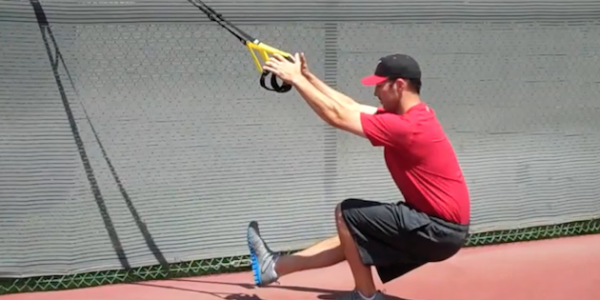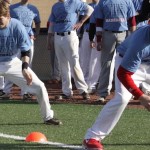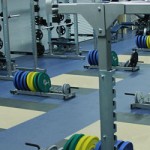Today, we are going to discuss the TRX 1-leg Squat. If you have never used the TRX before, check out An Introduction to TRX Suspension Training to learn a little more about it.
Basic TRX Squat
The squat is a basic movement that every human being, athlete and non-athlete, should be able to perform. Being able to perform even just a bodyweight squat can help build strength and flexibility in your quads, hamstrings, hips, and butt. Developing and perfecting a basic squat is essential for transitioning into other training movements such as back squats, front squats, jump squats, and box jumps. For a baseball player, all of these movements can translate to on-field performance allowing for more power when throwing, hitting, and running. But it starts with a strong foundation and mastering the bodyweight squat.
For the sake of this article, let’s first look at the basic TRX squat, which utilizes a little help from the TRX to perform the movement.
- Adjust the TRX straps to mid-length.
- Face toward the anchor point with both feet on the ground, and your feet set up in a good squat stance (about hip width or a little wider).
- Hold the handles with a slight bend in your elbows, and place tension in the straps by slightly leaning your body back.
- To begin the movement, sit your hips back and down into a squat position. Keep your heels on the ground and your knees over your ankles. Maintain good posture and avoiding rounding forward with your back.
- Drive your heels through the ground to return to the starting position. Repeat.
Benefits of Single Leg Training
Once you have the hang of some basic double leg training, it’s time to add some single leg exercises to your training program.
Think about the game of baseball and how your body moves to perform a task. Pitchers balance on one leg as they stride down the mound. They follow through and finish a pitch on one leg. Hitters will load up on their back leg and then during their swing utilize their front leg to stabilize and hit against. When running, a ballplayer is really supported by just one leg at a time – this goes for all athletes. What I am getting at here, is that baseball (and sports in general) utilizes a lot of single leg movements to perform the task at hand. So wouldn’t it make sense to incorporate single leg exercises into your training program?
Now, I am not implying that traditional double leg exercises are of no value. In fact, squats and deadlifts should be strong staples of any strength and conditioning program. However, they should not be the only leg work you do. Squats and deadlifts will definitely help you gain strength and power. But, these exercises utilize mostly prime movers and do not engage the muscles that act as dynamic stabilizers. Mike Boyle, strength coach for the Boston Red Sox, actually states that the one leg squat will utilize three muscles that do not engage in a double leg squat – the gluteus medius, the adductors, and the quadratus lumborum.
Again, these act as stabilizers and not primary movers. The engagement and improved strength of stabilizing muscles help in the prevention of injury. Furthermore, control of the athlete’s bodyweight must be established as balance comes into play. Can you see where these important aspects can transfer to the baseball diamond? With so many additional benefits, you would be doing yourself a disservice if you did not include single leg movements in your training program.
Now, while their are numerous single leg exercises we could discuss, today we will just touch on the TRX 1-leg Squat as it’s a good first single leg exercise to learn and master.
TRX 1-leg Squat
An athlete should have solid form on the basic TRX squat shown above and be able to execute a few sets without any decrease in that form before progressing to a tougher squat variation. The TRX 1-leg Squat can provide all the benefits seen in the basic TRX squat, but with a little more challenge to develop single leg strength and balance through a full range of motion. The TRX 1-leg Squat should be performed as follows:
- Adjust the TRX straps to mid-length.
- Face toward the anchor point with one foot on the ground, and the other foot straight out in front of your body with your knee straight.
- Hold the handles with a slight bend in your elbows, and place tension in the straps by slightly leaning your body back.
- To begin the movement, sit your hips back and down into a squat position. Keep your heel on the ground and your knees over your ankle. Maintain good posture and avoiding rounding forward with your back.
- Drive your heel through the ground to return to the starting position. Repeat.
If it is too difficult to complete with correct form, switch back to the basic TRX Squat with both feet on the ground. Once you master the TRX 1-leg Squat, then you can look at advancing to other tougher single leg exercises.
For more information on the TRX, visit the TRX website.
—
References:
- Boyle, Michael. “The Case for Single Limb Training” T-Nation. Web.







One response to “TRX Single Leg Squat”
[…] to groove proper squat mechanics with box squats, basic TRX assisted squats or goblet squats can help clean up your issues with butt wink. If you have hip pain or any issues […]